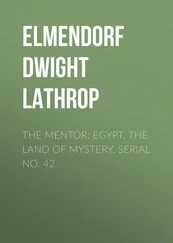Dwight Elmendorf - The Mentor - The Yosemite Valley, Vol 4, Num. 16, Serial No. 116, October 2, 1916
Здесь есть возможность читать онлайн «Dwight Elmendorf - The Mentor - The Yosemite Valley, Vol 4, Num. 16, Serial No. 116, October 2, 1916» — ознакомительный отрывок электронной книги совершенно бесплатно, а после прочтения отрывка купить полную версию. В некоторых случаях можно слушать аудио, скачать через торрент в формате fb2 и присутствует краткое содержание. Жанр: foreign_antique, foreign_prose, на английском языке. Описание произведения, (предисловие) а так же отзывы посетителей доступны на портале библиотеки ЛибКат.
- Название:The Mentor: The Yosemite Valley, Vol 4, Num. 16, Serial No. 116, October 2, 1916
- Автор:
- Жанр:
- Год:неизвестен
- ISBN:нет данных
- Рейтинг книги:3 / 5. Голосов: 1
-
Избранное:Добавить в избранное
- Отзывы:
-
Ваша оценка:
- 60
- 1
- 2
- 3
- 4
- 5
The Mentor: The Yosemite Valley, Vol 4, Num. 16, Serial No. 116, October 2, 1916: краткое содержание, описание и аннотация
Предлагаем к чтению аннотацию, описание, краткое содержание или предисловие (зависит от того, что написал сам автор книги «The Mentor: The Yosemite Valley, Vol 4, Num. 16, Serial No. 116, October 2, 1916»). Если вы не нашли необходимую информацию о книге — напишите в комментариях, мы постараемся отыскать её.
The Mentor: The Yosemite Valley, Vol 4, Num. 16, Serial No. 116, October 2, 1916 — читать онлайн ознакомительный отрывок
Ниже представлен текст книги, разбитый по страницам. Система сохранения места последней прочитанной страницы, позволяет с удобством читать онлайн бесплатно книгу «The Mentor: The Yosemite Valley, Vol 4, Num. 16, Serial No. 116, October 2, 1916», без необходимости каждый раз заново искать на чём Вы остановились. Поставьте закладку, и сможете в любой момент перейти на страницу, на которой закончили чтение.
Интервал:
Закладка:
Dwight L. Elmendorf
The Mentor: The Yosemite Valley, Vol 4, Num. 16, Serial No. 116, October 2, 1916
The Incomparable Yosemite
No temple made with hands can compare with the Yosemite. Every rock in its walls seems to glow with life. Some lean back in majestic repose; others, absolutely sheer or nearly so for thousands of feet, advance beyond their companions in thoughtful attitudes, giving welcome to storms and calms alike, seemingly aware, yet heedless, of everything going on about them.
Awful in stern, immovable majesty, how softly these rocks are adorned, and how fine and reassuring the company they keep: their feet among beautiful groves and meadows, their brows in the sky, a thousand flowers leaning confidingly against their feet, bathed in floods of water, floods of light, while the snow and waterfalls, the winds and avalanches and clouds shine and sing and wreathe about them as the years go by, and myriads of small winged creatures – birds, bees, butterflies – give glad animation and help to make all the air into music.
Down through the middle of the Valley flows the crystal Merced, River of Mercy, reflecting lilies and trees and the onlooking rocks; things frail and fleeting and types of endurance meeting here and blending in countless forms, as if into this one mountain mansion Nature had gathered her choicest treasures to draw her lovers into close and confiding communion with her.
JOHN MUIR.THE YOSEMITE VALLEY
The Story of the Valley
It was once said that “a man has to be an awful liar to tell the truth about California”; and this applies especially to the wonderful Yosemite (yo-sem´-it-ee) Valley. The name Yosemite means “full grown grizzly bear.” The Valley lies on the west slope of the Sierra Nevada range, and is washed by the Merced River.
There is no record of the early Spanish settlers of California ever having known the Yosemite. It was always a stronghold for the mountain tribes of Indians, and descendants of the Yosemite Indians still live there.
During the gold rush to California, in 1849, a prospector wandering on a trail up the Merced River was the first white man to view this beautiful region. Two years later a band of soldiers came upon the Valley suddenly while pursuing marauding Indians. The discovery came about in this way:
For some time previous to 1851 the Yosemite Indians, believing themselves secure in their mountain stronghold, had given a great deal of trouble to the military authorities of the United States by their defiant plundering. Major Savage, in command of the Mariposa Battalion of United States forces, at first tried to treat peaceably with them. The Yosemites, however, suspicious that Major Savage was merely attempting to get the tribe into his power, would not accept his offers. Then Major Savage went out after them. This was in the winter, and they had to break a trail through the snow. Suddenly they came in sight of a most wonderful valley. They went into camp on the bank of the Merced River, opposite the peak which is now known as El Capitan.
After the meal, in discussing this glorious spot which they had discovered, it was suggested that a name be given it. One of the party, Dr. Bunnell, proposed that it be called the “Yosemite Valley,” to perpetuate the name of the tribe that had so long made its home there. This name was unanimously adopted.
The expedition remained one day and two nights in the Valley, and then were forced to hurry out at the approach of a storm. In three days they had made the round trip through the Valley, exploring it in a general way, and had named some of its principal features. The Indians whom they had gone out to capture, however, were not seen. Later, in 1851, another expedition was made to the Valley in pursuit of the Indians. This was in charge of Capt. John Boling, and Dr. Bunnell accompanied the party. Several Indians were captured, and additional explorations were made.
Not many visits were made to the Valley before 1855. The first regular tourists’ visit was made by J. M. Hutchings, who, having heard of its wonderful scenery, collected a party and went there. The following year regular tourist travel began. The first house built in the Yosemite Valley was erected in 1855. This was afterwards known as Black’s Hotel. It was situated directly opposite the Yosemite Fall. Years ago the old Sentinel Hotel was built by the side of the Merced River, and as patronage increased three cottage annexes to this simple hostelry were erected – one immediately adjoining the hotel building and two across the road. In time a small village grew up along the road and camps were established in the meadows and woods near by. The old Sentinel has now given way to the large new hotel across the river near the foot of the falls. This opens in the beginning of 1917.
The first permanent settler in the Yosemite Valley was J. C. Lamon, who built a cabin in the very end of it in 1860 and planted gardens and orchards. Four years later an act of Congress granted the Valley itself and the adjacent territory to the State of California on the condition that it be held forever as a public park. In 1905, however, California gave back the Valley to the United States, and it now forms part of the Yosemite National Park, which was created in 1890.
THE YOSEMITE VALLEY
The Waterfalls
The finest photograph is inadequate to convey to the mind a satisfactory impression of the Yosemite Falls. The Yosemite Creek descends to the valley floor in three leaps, with a total height of about 2,500 feet. It is the highest known cataract in the world. The upper fall has a vertical descent of 1,430 feet; the middle fall consists of a series of cascades, with a total descent of 626 feet; while the lower fall is 320 feet high. At the top the Yosemite Falls is about 35 feet wide. As the season advances and the volume of water decreases, the fall dwindles considerably. At its best, however, it is one of the grandest features of the Valley. In winter a splendid ice cone, 500 feet high, forms at the foot of the upper fall.
Near Cathedral Spires, the Bridal Veil Fall pours down. People love it for its delicate, spirit-like beauty. It has a clear vertical fall of about 630 feet, with a width of 50 to 70 feet. The name is derived from the effect on it of the wind, which makes it flutter like a white veil.
The Bridal Veil shoots from the upper ledge of the cliff by the velocity the stream has acquired in descending a long slope above the head of the fall. Usually the fall strikes on flat topped slabs, which form a kind of ledge about two-thirds of the way down. Between four and five o’clock in the afternoon beautiful rainbows may be seen in this fall.
The Nevada Falls, 594 feet high, is generally ranked next to the Yosemite in interest. It is a heavy, turbulent cataract. Before reaching the bottom of its plunge the fall is broken and scattered by a sloping portion of the cliff about half-way down. It is the stormiest and whitest of all the falls in the Valley.
The Vernal Falls has a vertical descent of 317 feet and varies in width from 70 to 80 feet. This fall is an orderly, graceful, easy-going one. It may be more closely approached than any other. Just above it is the beautiful Emerald Pool.
The Illilouette Falls has a total height of about 370 feet. It is not so impressive as the upper Yosemite, nor so symmetrical as the Vernal, nor so graceful as Bridal Veil, nor so stormy a gush as Nevada; but, as John Muir says, “In the exquisite fineness and richness of texture of its flowing folds, it surpasses them all.”
There are many other small falls and cascades in the Yosemite Valley, among them being the Yosemite Gorge Fall and Cascades, the Royal Arch Falls, the Two Sentinel Cascades, and the falls of Cascade and Tamarack Creeks. The Royal Arch Fall in time of high water is beautiful; and the Two Sentinel Cascades, 3,000 feet high, are also wonderful spectacles. By the middle of summer, however, these have diminished so greatly that they are hardly noticeable.
Читать дальшеИнтервал:
Закладка:
Похожие книги на «The Mentor: The Yosemite Valley, Vol 4, Num. 16, Serial No. 116, October 2, 1916»
Представляем Вашему вниманию похожие книги на «The Mentor: The Yosemite Valley, Vol 4, Num. 16, Serial No. 116, October 2, 1916» списком для выбора. Мы отобрали схожую по названию и смыслу литературу в надежде предоставить читателям больше вариантов отыскать новые, интересные, ещё непрочитанные произведения.
Обсуждение, отзывы о книге «The Mentor: The Yosemite Valley, Vol 4, Num. 16, Serial No. 116, October 2, 1916» и просто собственные мнения читателей. Оставьте ваши комментарии, напишите, что Вы думаете о произведении, его смысле или главных героях. Укажите что конкретно понравилось, а что нет, и почему Вы так считаете.










![Anne Blunt - A Pilgrimage to Nejd, the Cradle of the Arab Race. Vol. 1 [of 2]](/books/749489/anne-blunt-a-pilgrimage-to-nejd-the-cradle-of-the-thumb.webp)

